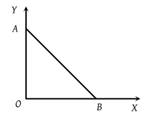Point charge q1 = 2 μC and q2 = –1 μC are kept at points x = 0 and x = 6 respectively. Electrical potential will be zero at points
(1) x = 2 and x = 9
(2) x = 1 and x = 5
(3) x = 4 and x = 12
(4) x = –2 and x = 2
Equipotential surfaces associated with an electric field which is increasing in magnitude along the x-direction are
(1) Planes parallel to yz-plane
(2) Planes parallel to xy-plane
(3) Planes parallel to xz-plane
(4) Coaxial cylinders of increasing radii around the x-axis
A bullet of mass 2 gm is having a charge of 2 μC. Through what potential difference must it be accelerated, starting from rest, to acquire a speed of 10 m/s ?
(1) 5 kV
(2) 50 kV
(3) 5 V
(4) 50 V
In a certain charge distribution, all points having zero potential can be joined by a circle \(S.\) The points inside \(S\) have positive potential, and points outside \(S\) have a negative potential. A positive charge, which is free to move, is placed inside \(S.\) What is the correct statement about \(S\):
| 1. | It will remain in equilibrium |
| 2. | It can move inside \(S,\) but it cannot cross \(S\) |
| 3. | It must cross \(S\) at some time |
| 4. | It may move, but will ultimately return to its starting point |
A square of side ‘a’ has charge Q at its centre and charge ‘q’ at one of the corners. The work required to be done in moving the charge ‘q’ from the corner to the diagonally opposite corner is -
(1) Zero
(2)
(3)
(4)
As per this diagram a point charge +q is placed at the origin O. Work done in taking another point charge –Q from the point A [co-ordinates (0, a)] to another point B [co-ordinates (a, 0)] along the straight path AB is

(1) Zero
(2)
(3)
(4)
Two charges \(q_1\) and \(q_2\) are placed \(30~\text{cm}\) apart, as shown in the figure. A third charge \(q_3\) is moved along the arc of a circle of radius \(40~\text{cm}\) from \(C\) to \(D.\) The change in the potential energy of the system is \(\dfrac{q_{3}}{4 \pi \varepsilon_{0}} k,\) where \(k\) is:

| 1. | \(8q_2\) | 2. | \(8q_1\) |
| 3 | \(6q_2\) | 4. | \(6q_1\) |
Two thin wire rings each having a radius R are placed at a distance d apart with their axes coinciding. The charges on the two rings are +q and –q. The potential difference between the centres of the two rings is -
(1) Zero
(2)
(3)
(4)
A hollow metallic sphere of radius R is given a charge Q. Then the potential at the centre is -
(1) Zero
(2)
(3)
(4)
A capacitor is charged by using a battery which is then disconnected. A dielectric slab is then slipped between the plates, which results in -
(1) Reduction of charge on the plates and increase of potential difference across the plates
(2) Increase in the potential difference across the plate, reduction in stored energy, but no change in the charge on the plates
(3) Decrease in the potential difference across the plates, reduction in the stored energy, but no change in the charge on the plates
(4) None of the above






